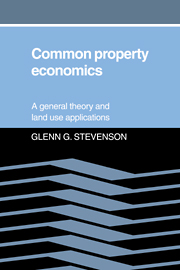Book contents
- Frontmatter
- Contents
- List of Tables and Figures
- Preface
- 1 What Is Common Property?
- 2 Open Access Theory
- 3 Common Property
- 4 The Swiss Grazing Commons
- 5 Comparisons with the English Open Field System
- 6 An Econometric Comparison of Commons and Private Grazing
- 7 The Structure and Performance of Common Property: Conclusions
- References
- Index
1 - What Is Common Property?
Published online by Cambridge University Press: 16 September 2009
- Frontmatter
- Contents
- List of Tables and Figures
- Preface
- 1 What Is Common Property?
- 2 Open Access Theory
- 3 Common Property
- 4 The Swiss Grazing Commons
- 5 Comparisons with the English Open Field System
- 6 An Econometric Comparison of Commons and Private Grazing
- 7 The Structure and Performance of Common Property: Conclusions
- References
- Index
Summary
A Confusion of Definition
Since the publication of Garrett Hardin's influential article in Science (1968), the “tragedy of the commons” has become a household phrase among economists and others concerned with environmental and natural resource problems. The concept has been used to explain overexploitation in fisheries, overgrazing, air and water pollution, abuse of public lands, population problems, extinction of species, fuelwood depletion, misallocation in oil and natural gas extraction, groundwater depletion, wildlife decline, and other problems of resource misallocation. Yet the rush to explain with a single concept a whole range of natural resource problems—which happen to be similar only in having multiple users—has obscured some important distinctions in the physical characteristics and the manner of use of these resources. We ought not to fall prey to a “tyranny of words,” as Learner (1983) in another context aptly warns, for the “tragedy of the commons” is such a catchy phrase that we are wont to apply it indiscriminately. We look about us and everywhere find resources being used by groups of people in common and are tempted to say, “Aha! Here is another ‘tragedy of the commons.’ ”
What is this “tragedy of the commons”? The next chapter reviews the theory behind it in detail, but I will state it briefly and intuitively here. Where resource use is unlimited, many users are present, and there is excess demand for the resource, overexploitation results.
- Type
- Chapter
- Information
- Common Property EconomicsA General Theory and Land Use Applications, pp. 1 - 7Publisher: Cambridge University PressPrint publication year: 1991



